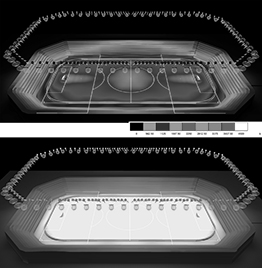Lighting for Stadiums
Illumination of stadiums is rather painstaking and responsible process, which should be developed by professional lighting designer, as a lot of Intricacies and details must be considered. Not a long time ago sporting events had been held only in the daytime, but alongside with either an active technology development or high popularization of sport all around the world strong necessity of day-and-night illumination of athletic fields appeared.
The important part is to find a compromise between the stadium area and the level of illumination. Shortage or abundance (excessive presence) of light on the field, its unbalanced distribution, the wrong choice of lighting devices – all this can affect adversely the physical and mental state of athletes, resulting in loss of concentration and attention, overfatigue of eyesight, general discomfort, reduce of the ability to respond quickly and make decisions.
Since most of the stadiums are open structures, lighting fixtures receive an additional burden in the form of weather protection – from moisture, dust, extreme temperatures and strong wind gusts.
Another point that requires a strong attention is what mode of stadium at the time of lighting. For different purposes different modes are used. Competitions with TV coverage require brighter light than the competition without shooting. The least bright light is used for training athletes.
Highlighting of the stands should be less intense, that’s why constructions with fixtures are placed outside the field of view of the observers. This is usually done by placing (locating) towers with equipment directly behind the bleachers.
The short list of requirements, affecting the choice of lighting fixtures for illumination of stadiums
- Appropriate European and national lighting standards;
- Right colour temperature;
- Absence of glares, blinks, flare light;
- Energy efficiency, environmental friendliness of equipment;
- Correspondence between price and quality;
- Reliability and durability of lighting fixtures.
Today metal-halide light sources are used for illumination of stadiums, as far as they let approximate illumination of sport fields almost to ideal. LED-based lighting is less effective and more expensive for this purpose, but this branch has a rapid growth and there is a strong possibility that LED-technologies will be able to move to the fore for illumination of stadiums in the nearest future.
The best lighting for stadiums:
|
Fael Philips Thorn Zumtobel |

